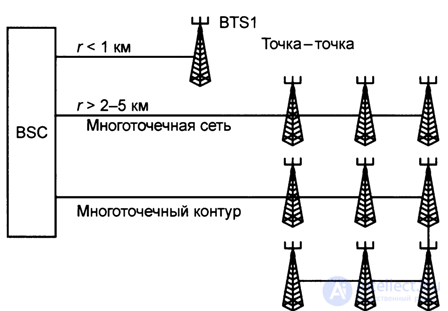Lecture
The BSS base station subsystem includes BTS base transceiver stations (the number of which is determined by the number of cells within the service area of the cellular operator) associated with the BSC base station controller. It is BTS that provide interaction with mobile stations and transmit information over communication lines (radio relay or fiber-optic) to the BSC. At the same time, numerous operations are carried out on the BTSoMS line, the main ones of which are:
 - establishing communication;
- establishing communication;
- transfer (reception) of speech and control information;
- location of mobile stations and handover;
- roaming;
- power management BTS and MS;
- authentication and identification, etc.
The BSS network topology consists of several types of BTScBSC connections (Fig. 5.1):
- point-to-point (point-to-point) at small distances between the BTS and BSC (up to 1 km);
- multi-tap (multipoint) system (network) (multidrop chain);
- multipoint loop (multidrop loop).
The last two chains are used at distances between BTS and BSC for more than a few kilometers, while the interaction between BTS and BSC is implemented using the E1 standard (2 Mbps speed).
Comments
To leave a comment
GSM Basics
Terms: GSM Basics